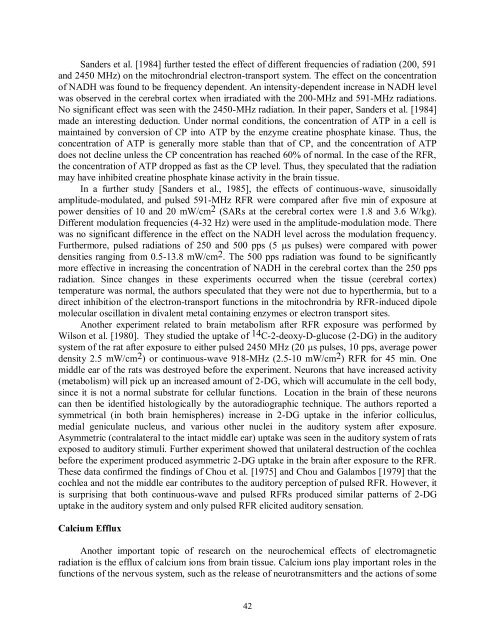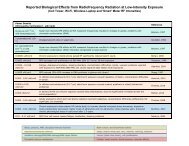Evidence for Effects on Neurology and Behavior - BioInitiative Report
Evidence for Effects on Neurology and Behavior - BioInitiative Report
Evidence for Effects on Neurology and Behavior - BioInitiative Report
Create successful ePaper yourself
Turn your PDF publications into a flip-book with our unique Google optimized e-Paper software.
S<strong>and</strong>ers et al. [1984] further tested the effect of different frequencies of radiati<strong>on</strong> (200, 591<br />
<strong>and</strong> 2450 MHz) <strong>on</strong> the mitochr<strong>on</strong>drial electr<strong>on</strong>-transport system. The effect <strong>on</strong> the c<strong>on</strong>centrati<strong>on</strong><br />
of NADH was found to be frequency dependent. An intensity-dependent increase in NADH level<br />
was observed in the cerebral cortex when irradiated with the 200-MHz <strong>and</strong> 591-MHz radiati<strong>on</strong>s.<br />
No significant effect was seen with the 2450-MHz radiati<strong>on</strong>. In their paper, S<strong>and</strong>ers et al. [1984]<br />
made an interesting deducti<strong>on</strong>. Under normal c<strong>on</strong>diti<strong>on</strong>s, the c<strong>on</strong>centrati<strong>on</strong> of ATP in a cell is<br />
maintained by c<strong>on</strong>versi<strong>on</strong> of CP into ATP by the enzyme creatine phosphate kinase. Thus, the<br />
c<strong>on</strong>centrati<strong>on</strong> of ATP is generally more stable than that of CP, <strong>and</strong> the c<strong>on</strong>centrati<strong>on</strong> of ATP<br />
does not decline unless the CP c<strong>on</strong>centrati<strong>on</strong> has reached 60% of normal. In the case of the RFR,<br />
the c<strong>on</strong>centrati<strong>on</strong> of ATP dropped as fast as the CP level. Thus, they speculated that the radiati<strong>on</strong><br />
may have inhibited creatine phosphate kinase activity in the brain tissue.<br />
In a further study [S<strong>and</strong>ers et al., 1985], the effects of c<strong>on</strong>tinuous-wave, sinusoidally<br />
amplitude-modulated, <strong>and</strong> pulsed 591-MHz RFR were compared after five min of exposure at<br />
power densities of 10 <strong>and</strong> 20 mW/cm 2 (SARs at the cerebral cortex were 1.8 <strong>and</strong> 3.6 W/kg).<br />
Different modulati<strong>on</strong> frequencies (4-32 Hz) were used in the amplitude-modulati<strong>on</strong> mode. There<br />
was no significant difference in the effect <strong>on</strong> the NADH level across the modulati<strong>on</strong> frequency.<br />
Furthermore, pulsed radiati<strong>on</strong>s of 250 <strong>and</strong> 500 pps (5 s pulses) were compared with power<br />
densities ranging from 0.5-13.8 mW/cm 2 . The 500 pps radiati<strong>on</strong> was found to be significantly<br />
more effective in increasing the c<strong>on</strong>centrati<strong>on</strong> of NADH in the cerebral cortex than the 250 pps<br />
radiati<strong>on</strong>. Since changes in these experiments occurred when the tissue (cerebral cortex)<br />
temperature was normal, the authors speculated that they were not due to hyperthermia, but to a<br />
direct inhibiti<strong>on</strong> of the electr<strong>on</strong>-transport functi<strong>on</strong>s in the mitochr<strong>on</strong>dria by RFR-induced dipole<br />
molecular oscillati<strong>on</strong> in divalent metal c<strong>on</strong>taining enzymes or electr<strong>on</strong> transport sites.<br />
Another experiment related to brain metabolism after RFR exposure was per<str<strong>on</strong>g>for</str<strong>on</strong>g>med by<br />
Wils<strong>on</strong> et al. [1980]. They studied the uptake of 14 C-2-deoxy-D-glucose (2-DG) in the auditory<br />
system of the rat after exposure to either pulsed 2450 MHz (20 s pulses, 10 pps, average power<br />
density 2.5 mW/cm 2 ) or c<strong>on</strong>tinuous-wave 918-MHz (2.5-10 mW/cm 2 ) RFR <str<strong>on</strong>g>for</str<strong>on</strong>g> 45 min. One<br />
middle ear of the rats was destroyed be<str<strong>on</strong>g>for</str<strong>on</strong>g>e the experiment. Neur<strong>on</strong>s that have increased activity<br />
(metabolism) will pick up an increased amount of 2-DG, which will accumulate in the cell body,<br />
since it is not a normal substrate <str<strong>on</strong>g>for</str<strong>on</strong>g> cellular functi<strong>on</strong>s. Locati<strong>on</strong> in the brain of these neur<strong>on</strong>s<br />
can then be identified histologically by the autoradiographic technique. The authors reported a<br />
symmetrical (in both brain hemispheres) increase in 2-DG uptake in the inferior colliculus,<br />
medial geniculate nucleus, <strong>and</strong> various other nuclei in the auditory system after exposure.<br />
Asymmetric (c<strong>on</strong>tralateral to the intact middle ear) uptake was seen in the auditory system of rats<br />
exposed to auditory stimuli. Further experiment showed that unilateral destructi<strong>on</strong> of the cochlea<br />
be<str<strong>on</strong>g>for</str<strong>on</strong>g>e the experiment produced asymmetric 2-DG uptake in the brain after exposure to the RFR.<br />
These data c<strong>on</strong>firmed the findings of Chou et al. [1975] <strong>and</strong> Chou <strong>and</strong> Galambos [1979] that the<br />
cochlea <strong>and</strong> not the middle ear c<strong>on</strong>tributes to the auditory percepti<strong>on</strong> of pulsed RFR. However, it<br />
is surprising that both c<strong>on</strong>tinuous-wave <strong>and</strong> pulsed RFRs produced similar patterns of 2-DG<br />
uptake in the auditory system <strong>and</strong> <strong>on</strong>ly pulsed RFR elicited auditory sensati<strong>on</strong>.<br />
Calcium Efflux<br />
Another important topic of research <strong>on</strong> the neurochemical effects of electromagnetic<br />
radiati<strong>on</strong> is the efflux of calcium i<strong>on</strong>s from brain tissue. Calcium i<strong>on</strong>s play important roles in the<br />
functi<strong>on</strong>s of the nervous system, such as the release of neurotransmitters <strong>and</strong> the acti<strong>on</strong>s of some<br />
42



